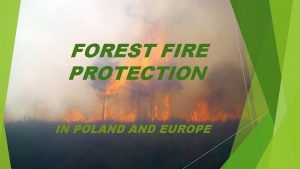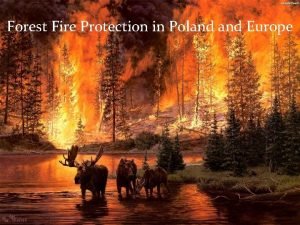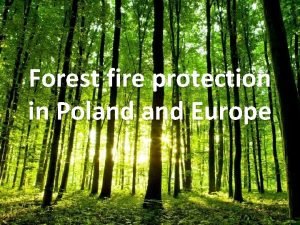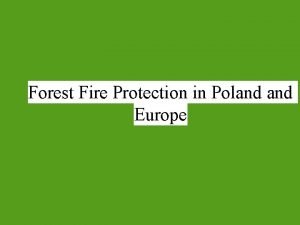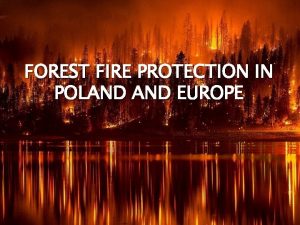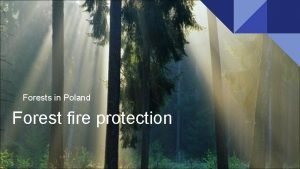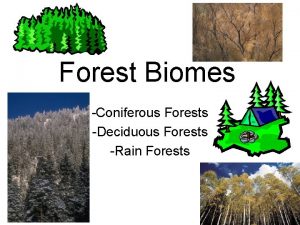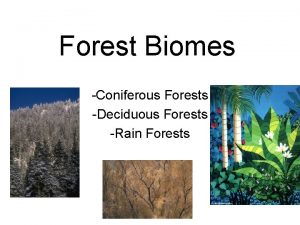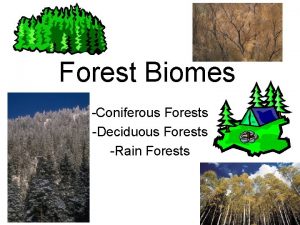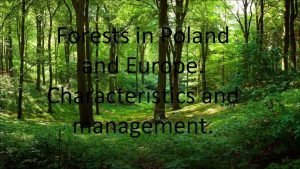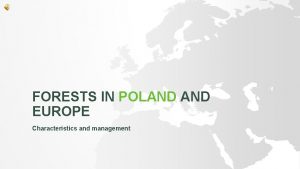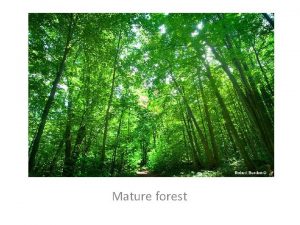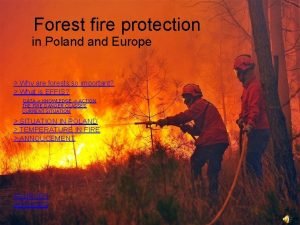FOREST FIRE PROTECTION IN POLAND EUROPE Forests in
















- Slides: 16

FOREST FIRE PROTECTION IN POLAND EUROPE

Forests in the world and in Europe � The total area of the world's forests is approximately 4, 033, 060 thousand ha. The average forest cover in countries around the world (in relation to land area) is approximately 31% (about 0. 60 ha of forest per 1 person, ie. about 2. 5 times higher than in Poland). � The countries with the largest forest area (as a percentage of total forest area of the world) are: Russia (20%), Brazil (13%), Canada (8%), USA (7%) and China (5%). European Union countries with the forest area of about 157 million hectares constitute about 4% of the world's forests. Poland (9. 3 million ha) occupies the 55 th place in regard to the forest area.


Forests area in Poland � We have a huge variety of forests in Poland. Among forested areas we can find: Δ hornbeam forests, Δ mixed forests, Δ riparian forests This dominance of different types of forests allows us to be one of the most famous countries for the most diverse and the richest forest stands in Central Europe. � Polish woodiness amounts to 30. 5%. This figure is also close to the amount of woods of Europe in general (without Russia), which constitutes 32. 2%

Forest area in Portugal � whats determine 38% of total country area Overall forest area in Portugal is about 3. 5 million ha, whats determine 38% of total country area. Main trees, which grows there, are pine, oak and eucalyptus. Coastal pine grows mainly in middle and northern part of the country, at the height of 700 -900 m. a. s. l. Deciduous forests, consisting of green and cork oak are situated mostly on the southern Portugal’s part and on the coastal belt. Eucalyptus grows on the Atlantic quayside. The vast majority of forests is in private owners possession. Only 2. 2% of Portuguese forests are state-owned, 76. 7% is private, 7. 7% is possessed by forestry companies and the rest is municipal.

In the Portugal we can find � 12 nature parks, � 9 forest reserves, � 9 state reserves � 3 landscape parks Total protected forest area is 587 102 ha, what is 18% of all forests. One of the most famous Portugal’s nature reserves is Peneda-Gerês National Park, also known simply as Gerês. It is located in the Norte region, in the northwest of the country. Gerês was created in 1971 and it’s area reaches 70 thousands hectares.

� Forest cover in Portugal is really low relative to possibilities. If forest fires and deforestation were on the lower level there, it would be possible to afforest about 60% of country area. Low forest cover in Portugal is mainly due to high fire susceptibility. In past 30 years forest fires swallowed more than a half (54%) of the total forest area. Forest fires, the present problem of Mediterranean ecosystems, were especially intense in 2003 and 2004. Cumulatively, about 20% of Portuguese forests had been burnt at that time. Their impact, and the impact of 2005’s fires, was big enough, to modified composition of entire forests cover in Portugal.

� Ways to protect forests We already know that Poland is one of the most wooded countries in Europe, which contributes to the fact that we are in the forefront of states in terms of forest fires. We occupy the 4 th place. Forest resources are extremely vulnerable to fires. The rate of forests prone to fires in Europe is about 65%. In Poland it is 85%. There are some areas where the risk of fire is the greatest. They include: • a high share of beaver habitats • pine dominance in speciess composition • tree age and availability (easy access). Old forests with rich forest structure and the undergrowth are the most dangerous because these places are where fires generally occur.

The biggest fires in European forests • Forest fire in Chernobyl 1986 • 600 000 firefighters were trying to deal with such a big fire • Forest fire near Kuźnia Raciborska 1992 • Probably the cause of the fire was a spark from a handling train • Forest fire in Greece 2007 • Scientists said that in 72 hours about 170 fires has blown up • Forest fire on the Canary Islands 2012 • About 5000 of citizens were evacuated • Forest fire on Siberia 2016 • About 6 000 ha were burnt out

The most common causes of fires are the following: • Adult carelessness and carelessness of minors; like smoking in the wood or making bonfires • Machines and devices; especially when electrical wires break, sparking of the braking system of the rail vehicles • Arson: The motives of these fires are sometimes the willingness to earn income for participation in firefighting The main tasks in forest fire protection include. . . • The patrolling of forest areas by specially trained forest rangers • The preparation and technical equipment of the service and the area so that the resulting fire can be quickly located and extinguished

ESTONIA � Estonia is located in northern Europe on the eastern coast of the Baltic Sea. � The territory of Estonia consists of a mainland 2, 222 islands and islets in the Baltic Sea covering 45, 339 km 2 of land water 50% of Estonia's territory is covered by forest land Ebavere Hill

� Estonia displays a great variety in forest types. � Two main types are forests growing on mineral soil (about 70%) and so -called swamp forests (about 30%), growing in the numerous wetland areas of Estonia. � The forest types can further be broken down into smaller categories, many with their own ecosystem and unique biotope. . The most common tree species are pine, birch and spruce. � About 70% of Estonian forests are commercially used (circa 1. 5 million hectares), with another 30% enjoying some kind of protection

Huge wooden megaphones in Pähni that help listen to the sound of the forest The most interesting areas on the itinerary are Lahemaa National Park and Soomaa National Parky

Table of Contents 1. Forests in the world and in Europe 2. FOREST FIRE PROTECTION 3. MAP 4. Forests area in Poland 5. Forest area in Portugal 6. In the Portugal we can find 8. Ways to protect forests 9. The biggest fires in European forests 11. ESTONIA 14. Table 15. List of Contents of source materials

List of source materials � http: //przegladbaltycki. pl/3815, wedrujac-sluchajac-estonskiegolasu. html � https: //www. bdl. lasy. gov. pl/portal/lasy-na-swiecie � https: //olawa 998. wordpress. com/2014/03/06/przyczyny-pozarowlasow-w-polsce/ � http: //www. wigry. org. pl/kwartalnik/nr 10_pozar. htm � http: //www. lasy. gov. pl/informacje/publikacje/informacjestatystyczne-i-raporty/Lasy_i_lesnictwo_UE_PL. pdf � Google graphic

Presentation authors 1. Miłosz Karpiński 2. Magdalena Burzyńska 3. Bartosz Stefański LICEUM OGÓLNOKSZTAŁCĄCE Z ODDZIAŁAMI DWUJĘZYCZNYMI IM. K. K. BACZYŃSKIEGO W LIDZBARKU WELSKIM, klasa 2 A
 Is poland considered eastern europe
Is poland considered eastern europe Forest health protection
Forest health protection Causes and effects of wildfires
Causes and effects of wildfires Forest cover europe
Forest cover europe National fire protection association
National fire protection association Hyattsville fire protection
Hyattsville fire protection Osha subpart for fire protection and prevention
Osha subpart for fire protection and prevention National fire protection association
National fire protection association Bureau of fire protection makati
Bureau of fire protection makati Proactive fire protection
Proactive fire protection Fcv fire protection
Fcv fire protection What is the subpart for fire protection and prevention
What is the subpart for fire protection and prevention National fire protection association
National fire protection association Cybor fire protection
Cybor fire protection 1910 fire extinguisher
1910 fire extinguisher Fire in forest
Fire in forest Fire in forest
Fire in forest



